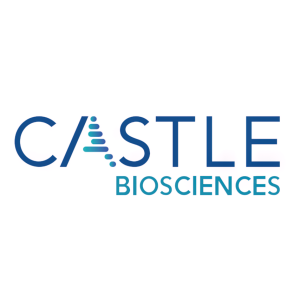TissueCypher® Test Results Can Increase the Likelihood of Appropriate Management Decisions for Barrett’s Esophagus Patients with Low-Grade Dysplasia
Castle Biosciences, Inc. (Nasdaq: CSTL) announced new findings from a patient simulation study to be presented at ESGE Days 2023. The study indicated that the TissueCypher® Barrett’s Esophagus test significantly enhances management decisions for patients with low-grade dysplasia (LGD) in Barrett’s esophagus (BE). Results showed that the likelihood of appropriate treatment increased from 9% with pathology alone to 77.3% when using TissueCypher results. This test may help reduce both unnecessary endoscopies for low-risk patients and improve outcomes for high-risk patients. The presentation will occur on April 22 in Dublin, Ireland, highlighting the potential of TissueCypher to standardize treatment and reduce the risk of advancing to esophageal cancer.
- Increased likelihood of appropriate management decisions from 9% to 77.3% using TissueCypher.
- Potential to reduce unnecessary endoscopies for low-risk patients and improve outcomes for high-risk patients.
- Study to be presented at ESGE Days 2023, highlighting clinical relevance.
- None.
Insights
Analyzing...
Data from patient simulation study to be presented at ESGE (
Overall, the study results showed that TissueCypher standardized the management of BE cases with LGD to improve health outcomes by potentially:
- Reducing the incidence and mortality of esophageal adenocarcinoma for high- and intermediate-risk patients through shorter surveillance intervals and/or endoscopic eradication therapy (EET).
- Reducing unnecessary use of EET and endoscopies for low-risk patients.
“Clinical guidelines recommend expert pathology review for a diagnosis of Barrett’s esophagus with low-grade dysplasia; however, expert review is highly variable and is not easily accessible for many patients,” said
In the patient simulation study, the percentage of cases with
Details of the study will be shared in an oral presentation during the upcoming ESGE Days 2023 meeting, presented by the
- Presentation title: A Tissue Systems Pathology Test Has Significant Clinical Utility to Standardize Management Leading to Improved Health Outcomes for Barrett’s Esophagus Patients with Low-Grade Dysplasia
-
Session: Barrett's Esophagus: Taking
Patient Care to the Next Level -
Day and Time:
Saturday, April 22 , at10:50 a.m. GMT (Irish local time) -
Location:
Liffey Meeting Room 2
About TissueCypher® Barrett’s Esophagus Test
The TissueCypher Barrett’s Esophagus test is Castle’s precision medicine test designed to predict future development of high-grade dysplasia (HGD) and/or esophageal cancer in patients with Barrett’s esophagus (BE). TissueCypher is indicated for use in patients with endoscopic biopsy confirmed BE that is graded non-dysplastic (ND), indefinite for dysplasia (IND) or low-grade dysplasia (LGD); its clinical performance has been supported by nine peer-reviewed publications of BE progressor patients with leading clinical centers around the world. The TissueCypher Barrett’s Esophagus test is a proprietary Laboratory Developed Test with its own unique CPT PLA code (0108U). Additionally, the test received Advanced Diagnostic Laboratory Test (ADLT) status from the
About
Castle’s current portfolio consists of tests for skin cancers, uveal melanoma, Barrett’s esophagus and mental health conditions. Additionally, the Company has active research and development programs for tests in other diseases with high clinical need, including its test in development to predict systemic therapy response in patients with moderate-to-severe psoriasis, atopic dermatitis and related conditions. To learn more, please visit www.CastleBiosciences.com and connect with us on LinkedIn, Facebook, Twitter and Instagram.
DecisionDx-Melanoma, DecisionDx-CMSeq, DecisionDx-SCC, MyPath Melanoma, DiffDx-Melanoma, DecisionDx-UM, DecisionDx-PRAME, DecisionDx-UMSeq, TissueCypher and IDgenetix are trademarks of
Forward-Looking Statements
This press release contains forward-looking statements within the meaning of Section 27A of the Securities Act of 1933, as amended, and Section 21E of the Securities Exchange Act of 1934, as amended, which are subject to the “safe harbor” created by those sections. These forward-looking statements include, but are not limited to, statements concerning: the potential of TissueCypher test results to (i) significantly improve the management of LGD in patients with BE compared to pathology alone, as well as improve health outcomes; (ii) standardize the management of BE patients with LGD to improve health outcomes by helping ensure that patients at a high risk of progression receive earlier interventions and by potentially reducing unnecessary use of EET and endoscopies for lower risk patients; (iii) reduce inconsistencies in management decisions for BE patients with LGD; and (iv) reduce the incidence and mortality of esophageal cancer and the use of unnecessary clinical treatments, when appropriate. The words “can,” “may,” “potential” and similar expressions are intended to identify forward-looking statements, although not all forward-looking statements contain these identifying words. We may not actually achieve the plans, intentions or expectations disclosed in our forward-looking statements, and you should not place undue reliance on our forward-looking statements. Actual results or events could differ materially from the plans, intentions and expectations disclosed in the forward-looking statements that we make. These forward-looking statements involve risks and uncertainties that could cause our actual results to differ materially from those in the forward-looking statements, including, without limitation: subsequent study or trial results and findings may contradict earlier study or trial results and findings or may not support the results shown in this study, including with respect to the discussion of TissueCypher in this press release; actual application of our tests may not provide the aforementioned benefits to patients; and the risks set forth under the heading “Risk Factors” in our Annual Report on Form 10-K for the year ended
View source version on businesswire.com: https://www.businesswire.com/news/home/20230420005095/en/
Investor Contact:
czuckero@castlebiosciences.com
Media Contact:
amarshall@castlebiosciences.com
Source:







